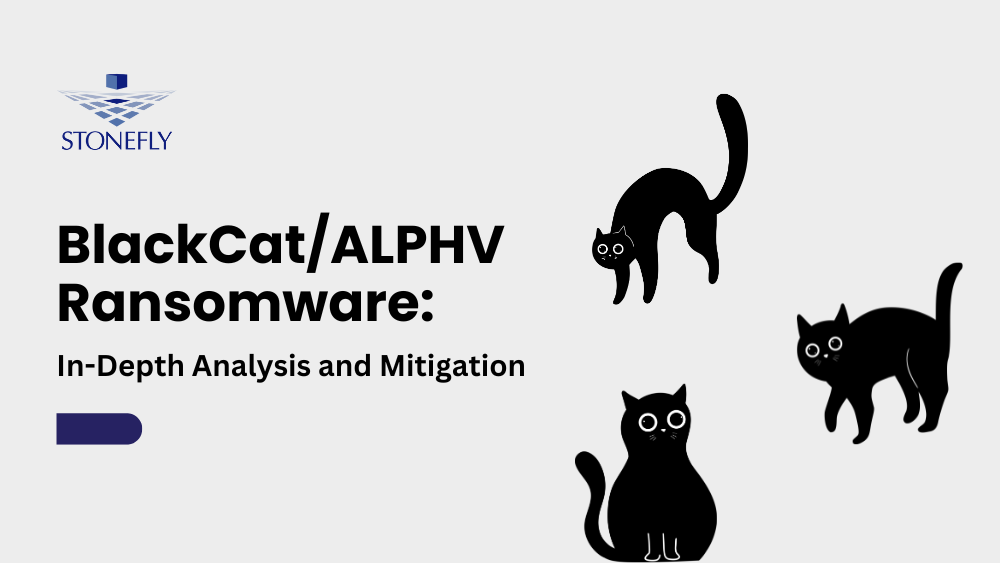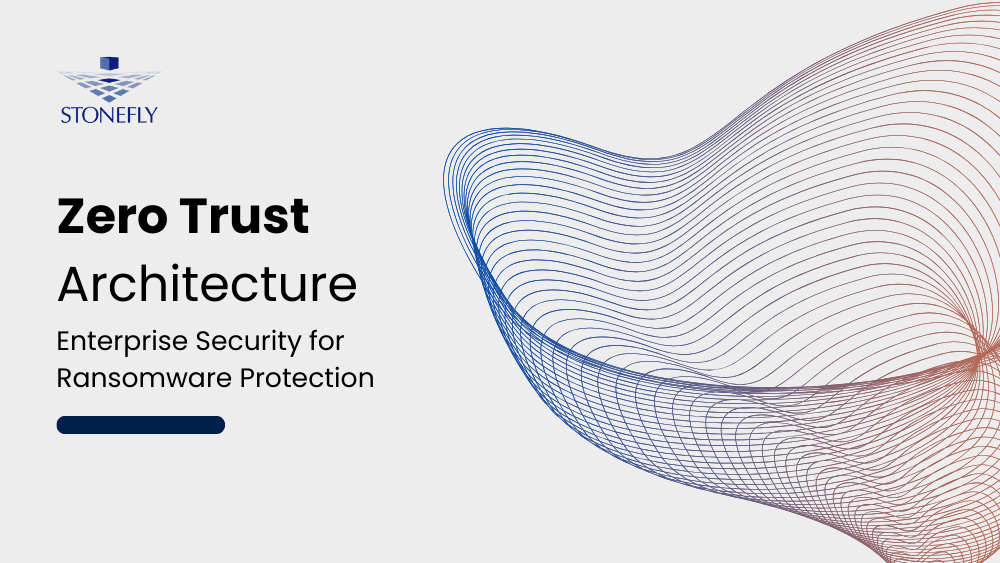In the wake of the recent BlackCat ransomware attack on Fidelity National Financial, the cybersecurity landscape has been jolted by the audacious tactics of this notorious threat, also identified as ALPHV ransomware. Beyond being just another name in the crowded ransomware arena, BlackCat poses a significant danger, leaving organizations and individuals vulnerable to its malicious intents. This comprehensive guide will navigate through the intricate details of BlackCat/ALPHV ransomware, shedding light on its origin, functionality, and the palpable impact it made.
Brief Overview of BlackCat/ALPHV Ransomware
BlackCat, also known as ALPHV, stands as a formidable variant within the ransomware realm, uniquely targeting Linux platforms—a distinctive feature setting it apart from its Windows-centric counterparts. Its notoriety is fueled by a sophisticated approach, employing a multi-stage deployment strategy. Exploiting vulnerabilities in exposed services or exploiting weak credentials, BlackCat infiltrates systems, navigating with a singular purpose: to encrypt critical data.
Once embedded within a target system, BlackCat employs a combination of symmetric and asymmetric encryption algorithms to lock files securely. Its evasion tactics include masquerading as legitimate system processes, ensuring a covert presence that avoids detection by conventional security measures. Having completed its encryption mission, BlackCat leaves a digital ransom note.
This ominous message provides instructions on contacting the attackers and outlines the steps to pay the ransom for the coveted decryption key. Understanding these intricacies becomes paramount for organizations seeking effective defense strategies against the looming threat of BlackCat/ALPHV ransomware.
Technical Details and Indicators of Compromise (IOC)
Ransomware Description: BlackCat/ALPHV
BlackCat/ALPHV is an advanced ransomware strain coded in Rust, marking a significant departure from conventional ransomware development. This strain exhibits a multi-faceted attack strategy, using previously compromised credentials for initial access and employing diverse techniques to disable security features and spread within the victim’s network.
Attack Vector: Initial Access
The initial access point for BlackCat/ALPHV involves exploiting vulnerabilities in Microsoft Exchange Server, with a specific focus on CVE-2021-26855, CVE-2021-26857, CVE-2021-26858, and CVE-2021-27065. Additionally, evidence indicates the exploitation of SSH keys to establish a foothold on the target machine. Other potential entry methods should not be disregarded.
Execution and Evasion Techniques
After gaining access, the ransomware utilizes a blend of PowerShell scripts and Cobalt Strike to disable security features, uninstall antivirus applications, and compromise Active Directory accounts. It employs Windows Task Scheduler to deploy malicious Group Policy Objects (GPOs) and uses PowerShell scripts like start.bat, est.bat, and run.bat for various stages of the attack.
Privilege Escalation and Defense Evasion
BlackCat/ALPHV executes privilege escalation through the CMSTPLUA COM interface, allowing it to escalate privileges and perform tasks with administrative rights. The malware disrupts the victim’s network by stopping services, deleting Volume Shadow Copies, and manipulating symbolic links. It utilizes various Windows administrative tools and Sysinternals tools during compromise.
Encryption and File Manipulation
The ransomware uses the AES algorithm to encrypt files, with the AES key itself encrypted using an RSA public key. Encrypted files have their extension changed to “uhwuvzu.” During the encryption process, the malware creates intermediary files named “checkpoints-<encrypted filename>.” It also alters the Desktop wallpaper, displaying a ransom note, and generates a PNG image named “RECOVER-uhwuvzu-FILES.txt.png.”
Lateral Movement and Exfiltration
BlackCat/ALPHV exhibits lateral movement capabilities, utilizing PsExec for propagation and executing on remote systems. It leverages remote control applications like RDP and MobaXterm for network traversal. Exfiltration is carried out using tools such as ExMatter, 7-Zip, Rclone, MEGASync, or WinSCP. FreeFileSync is observed as a tool for stealing information before the actual ransomware execution.
Command and Control (C2) Infrastructure
The ransomware establishes communication with its C2 server using a Base64-encoded PowerShell script with an embedded Cobalt Strike SMB beacon. It utilizes named pipes such as \\.\pipe\npfs_78 and \\.\pipe\fullduplex_9c for this purpose.
Indicators of Compromise (IOC)
MD5 Hashes:
- 861738dd15eb7fb50568f0e39a69e107
- 9f60dd752e7692a2f5c758de4eab3e6f
- 09bc47d7bc5e40d40d9729cec5e39d73
SHA256 Hashes (BlackCat Ransomware):
- 731adcf2d7fb61a8335e23dbee2436249e5d5753977ec465754c6b699e9bf161
- f837f1cd60e9941aa60f7be50a8f2aaaac380f560db8ee001408f35c1b7a97cb
C2 IPs:
- 44.9.243
- 234.157.246
- 134.20.66
- 220.102.253
- 120.238.58
- 89.247.207
- 144.121.93
- 163.252.230
- 153.160.140
- 106.223.97
- 60.161.161
- 0.77.15
- 232.41.155
File Names and Additional IOCs:
File Names:
- dll
- exe
- ini
Registry Keys:
- HKCU\Software\BlackCat
- HKLM\SYSTEM\ControlSet001\Services\BlackCatService
Network Signatures:
User-Agent:
- Mozilla/5.0 (Windows NT 10.0; Win64; x64) AppleWebKit/537.36 (KHTML, like Gecko) Chrome/58.0.3029.110 Safari/537.3
- POST /api.php
For a detailed account of the indicators of compromise, check out the FBI flash report.
Lifecycle of a BlackCat/ALPHV Ransomware Attack
Initial Access
BlackCat/ALPHV gains entry into targeted systems through various attack vectors and social engineering tactics. The attack vectors utilized are diverse and may exploit vulnerabilities in exposed services or rely on the use of weak credentials. Social engineering tactics may involve deceptive techniques to manipulate users into compromising security.
Attack Vectors
The ransomware employs a multi-faceted approach to gaining unauthorized access. It capitalizes on vulnerabilities present in exposed services or utilizes weak credentials to infiltrate target systems. This versatile strategy allows BlackCat/ALPHV to exploit a range of potential weaknesses in the target environment.
Social Engineering Tactics
Beyond technical means, BlackCat/ALPHV leverages social engineering tactics to trick individuals within the targeted organization. These tactics may include phishing emails, deceptive messages, or other manipulative techniques designed to trick users into unknowingly granting access or executing malicious actions.
Execution and Propagation
Once initial access is established, BlackCat/ALPHV executes its malicious payload and begins to propagate within the compromised network. The ransomware uses various techniques to escalate privileges and navigate through the network, identifying critical data to encrypt.
Encryption Process
BlackCat/ALPHV employs sophisticated encryption algorithms during the encryption process. While specific details about these algorithms are not publicly disclosed, ransomware typically utilizes a combination of symmetric and asymmetric encryption to render files inaccessible. This encryption process ensures that valuable data is securely locked and inaccessible to the victim.
Ransom Note and Communication
Upon successful encryption, BlackCat/ALPHV leaves a ransom note containing instructions on how victims can contact the attackers and pay a ransom for the decryption key. This communication marks the initiation of negotiations between the attackers and the victimized organization, providing details on the ransom amount and payment methods.
Real-world Incidents and Impacts
Notable Attacks and Targets
Fidelity National Financial (FNF) Cybersecurity Incident (November 2023)
Fortune 500 insurance giant Fidelity National Financial (FNF) fell victim to a significant cybersecurity incident. The breach, confirmed through an 8-K filing with the Securities and Exchange Commission (SEC), led to the shutdown of key systems, affecting areas such as title insurance, escrow services, mortgage transactions, and technology services in the real estate and mortgage sectors. With over $11 billion in total revenue in 2022, FNF is a major underwriter of title insurance in the US.
The incident, which occurred in November 2023, involved an unauthorized intrusion into FNF systems, leading to the acquisition of specific credentials by the attacker. While the material impact on the company’s operations is still under assessment, the incident has caused disruptions, hindering real estate transactions and related services. The ransomware group ALPHV/BlackCat claimed responsibility, and investigations are ongoing to determine the full extent of the compromise. Security experts speculate that the attack might have exploited the CitrixBleed vulnerability affecting Citrix Netscaler devices.
MGM Resorts International Ransomware Attack (November 2023)
MGM Resorts International faced a ransomware attack, impacting various services such as websites, online reservations, ATMs, credit card machines, slot machines, and room keys across its locations in the US. Although officially referred to as a “cybersecurity issue,” the ALPHV/BlackCat hacking group is linked to the attack, reportedly employing social engineering tactics to compromise the company. The attack led to a decline in MGM Resorts shares, and Moody’s Corp. warned of potential credit rating implications. The FBI is monitoring the situation, emphasizing the growing risks associated with social engineering attacks.
Cyberattack on German Oil Companies by BlackCat (January 2023)
BlackCat ransomware group targeted two German oil companies, causing a significant cyberattack that affected hundreds of gas stations across northern Germany. The attack utilized a previously unknown gateway to compromise systems, leading to operational disruptions and declarations of force majeure by affected companies. The incident showcases the potential ripple effects on the supply chain, with Royal Dutch Shell rerouting supplies due to the attack. Links between BlackCat and other ransomware groups, such as Darkside and BlackMatter, highlight the evolving and interconnected nature of cyber threats.
Barts Health NHS Trust Cyberattack (July 2023)
Barts Health NHS Trust, comprising six hospitals and ten clinics in East London, faced a cyberattack attributed to the BlackCat ransomware group. The attackers claimed to have stolen over seven terabytes of sensitive data, including CVs, financial reports, and internal hospital information. The group threatened to release the data if the trust did not engage in negotiations. While the trust denied paying a ransom, concerns arose as the attackers posted claims on the dark web, creating uncertainties about potential data exposure and privacy breaches.
Lehigh Valley Health Network Ransomware Attack and Lawsuit (2023)
Lehigh Valley Health Network (LVHN) in the United States experienced a BlackCat ransomware attack that took an aggressive turn when the threat group published naked images of breast cancer patients on its data leak site. LVHN refused to pay the ransom, leading to a lawsuit alleging that the organization prioritized money over patient privacy. The legal action claims violations of multiple HIPAA provisions and negligence in implementing adequate measures to protect against ransomware attacks. The case highlights the ethical and legal challenges posed by cyberattacks on healthcare institutions.
Ransomware Attack on HWL Ebsworth and Australian Banks (April 2023)
Australian law firm HWL Ebsworth fell victim to a ransomware attack by the BlackCat group, leading to the theft of four terabytes of data, including sensitive client information. The incident impacted major Australian banks, including Westpac, NAB, the Commonwealth Bank, and ANZ, as they were clients of the law firm. The attack raises concerns about the exposure of client data and the need for improved cybersecurity defenses across sectors. The situation is part of a broader trend of ransomware groups targeting legal entities and their clients.
Japan Aviation Electronics Industry Cyberattack (November 2023)
Japanese electronics manufacturer Japan Aviation Electronics Industry faced a cyberattack attributed to the ALPHV/BlackCat ransomware group. While the company reported some delays in email communications, it stated that no information leakage had been confirmed. However, the ransomware group claimed to have stolen approximately 150,000 documents, including blueprints, contracts, and confidential messages. The incident underscores the persistent threats faced by major manufacturing entities and the potential economic and security implications of such attacks.
Consequences for Victims
The BlackCat ransomware group’s recent cyber onslaughts have left a trail of severe consequences across various sectors, underscoring the critical importance of robust cybersecurity practices. These incidents have not only disrupted operations but also led to financial losses, reputational damage, and legal ramifications for the affected entities.
Fidelity National Financial (FNF) Cybersecurity Incident (November 2023):
- Disruption of critical services in title insurance, escrow, and mortgage transactions.
- Delays in real estate transactions impacting home buyers.
- Ongoing financial assessment with potential long-term market repercussions.
MGM Resorts International Ransomware Attack (November 2023):
- Significant disruptions to services, including online reservations and financial transactions.
- Noticeable decline in stock value, prompting credit rating agency warnings.
Cyberattack on German Oil Companies by BlackCat (January 2023):
- Force majeure declarations affecting gas stations and supply chains.
- Operational limitations for oil companies and downstream impacts on services.
Barts Health NHS Trust Cyberattack (July 2023):
- Compromise of over seven terabytes of sensitive patient data.
- Threats to release data on the dark web, raising ethical and legal concerns.
- Emphasizes the urgent need for robust cybersecurity frameworks in healthcare.
Lehigh Valley Health Network Ransomware Attack and Lawsuit (2023):
- Disturbing escalation with the publication of sensitive patient data, including nude images.
- Lawsuit alleging negligence and prioritization of financial considerations over patient privacy.
- Highlights the ethical and legal dilemmas arising from cyber incidents in healthcare.
Ransomware Attack on HWL Ebsworth and Australian Banks (April 2023):
- Widespread consequences affecting major banks and clients of compromised entities.
- Exposure of sensitive client information and potential legal ramifications.
Japan Aviation Electronics Industry Cyberattack (November 2023):
- Operational disruptions, including delays in email communications.
- Claims of data theft by the Alphv/BlackCat group, posing risks to competitiveness.
- Highlights the broader economic implications of cyber threats for manufacturing industries.
These incidents collectively emphasize the urgency for collective efforts to enhance cybersecurity resilience across industries.
Financial and Operational Ramifications
The fallout from a BlackCat/ALPHV ransomware attack extends far beyond the immediate technical compromises. The financial and operational implications are substantial, often leaving organizations grappling with significant challenges.
Monetary Losses:
The financial toll of a BlackCat/ALPHV attack is multifaceted. Organizations are not only burdened with the ransom demand itself but also contend with the costs of investigating the incident, restoring systems, and implementing enhanced security measures. The ransom demanded by the threat actors may vary, but it is typically a considerable sum, adding a direct and immediate financial burden.
Business Disruption:
The operational disruption resulting from a ransomware attack is profound. BlackCat/ALPHV’s ability to encrypt files, disable critical services, and impede normal business operations can lead to downtime, causing a direct impact on productivity and revenue generation. Depending on the scope of the attack, businesses may find themselves unable to fulfill customer demands, meet contractual obligations, or maintain regular workflow.
Data Loss and Recovery:
The encrypted files, coupled with potential data exfiltration conducted by the attackers, pose a dual threat. Not only is there a risk of permanently losing access to vital data, but the compromised information may also be misused or publicly exposed, leading to reputational damage and potential legal consequences. Organizations are faced with the complex task of assessing what data has been compromised, recovering encrypted files, and ensuring the integrity of their systems.
Reputational Damage:
The reputational fallout from a BlackCat/ALPHV attack can be severe and enduring. Customers, partners, and stakeholders may lose trust in the organization’s ability to safeguard sensitive information. Public perception can be further exacerbated if the attackers publicize stolen data or if the incident becomes widely known. Rebuilding trust and restoring a damaged reputation can be a lengthy and challenging process.
Legal and Regulatory Consequences:
Ransomware attacks trigger legal and regulatory obligations, particularly concerning data protection and privacy. Depending on the jurisdiction, organizations may be required to report the incident to regulatory authorities and affected individuals. Failure to comply with these obligations can result in legal repercussions, including fines and sanctions, adding another layer of complexity to the aftermath of an attack.
Increased Security Costs:
In the aftermath of a BlackCat/ALPHV attack, organizations invariably face heightened security costs. This includes investments in upgrading and fortifying cybersecurity infrastructure, conducting thorough security audits, and implementing measures to prevent future incidents. The ongoing need for advanced threat detection and incident response capabilities becomes a critical consideration for long-term resilience.
Insurance Implications:
The surge in ransomware incidents has led to a reassessment of cybersecurity insurance policies. Insurers may revise terms and conditions, and premiums could increase for organizations perceived to be at a higher risk. Navigating the insurance landscape post-attack becomes a critical aspect of the recovery process.
How to Prepare for a BlackCat/ALPHV Ransomware Attack
As the threat landscape evolves, organizations must proactively strengthen their cybersecurity posture to mitigate the risk of a BlackCat/ALPHV ransomware attack. Preparedness is a key element in safeguarding against the financial and operational consequences associated with such incidents. Here are crucial measures to consider:
Threat Intelligence and Awareness
Continuous Monitoring:
Stay informed about emerging cyber threats, particularly those related to BlackCat/ALPHV. Engage with threat intelligence services and regularly monitor industry-specific threat feeds to stay ahead of evolving tactics and techniques employed by ransomware actors.
Employee Training:
Human error is a common entry point for ransomware attacks. Conduct regular training sessions to educate employees about phishing threats, social engineering tactics, and the importance of cybersecurity hygiene. A well-informed workforce is a crucial line of defense.
Information Sharing:
Participate in information-sharing initiatives within your industry or sector. Collaborate with peers and share insights on recent threats and incidents. Collective awareness and intelligence can enhance the overall cybersecurity resilience of the community.
Regular Security Audits and Vulnerability Assessments
Routine Audits:
Conduct regular security audits to assess the effectiveness of existing security controls and policies. Identify and rectify vulnerabilities promptly to reduce the attack surface and fortify the organization’s defenses.
Penetration Testing:
Engage in penetration testing exercises to simulate real-world attack scenarios. This proactive approach helps identify potential weaknesses in the network, applications, or infrastructure, allowing for timely remediation.
Patch Management:
Establish a robust patch management process to ensure that operating systems, software, and applications are promptly updated with the latest security patches. Regularly review and apply patches to address known vulnerabilities.
Secure Backup Strategies
Regular Backups:
Implement a comprehensive backup strategy that includes regular backups of critical data. Ensure that backups are automated, scheduled, and stored securely in an isolated environment to prevent them from being compromised in the event of an attack.
Testing Backups:
Periodically test the restoration process from backups to verify their integrity and effectiveness. A reliable backup solution is a cornerstone of recovery in the aftermath of a ransomware incident.
Incident Response Planning
Comprehensive Plan:
Develop a detailed incident response plan that outlines the steps to be taken in the event of a ransomware attack. Assign roles and responsibilities, establish communication protocols, and define the escalation path for different scenarios.
Tabletop Exercises:
Conduct tabletop exercises to simulate ransomware incidents and test the organization’s response capabilities. This enables key stakeholders to practice their roles, identify gaps in the plan, and refine the response strategy.
Engage with Law Enforcement:
Establish connections with law enforcement agencies and relevant cybersecurity authorities. In the event of an attack, collaboration with law enforcement can enhance the chances of tracking and apprehending the threat actors.
Legal and Regulatory Compliance:
Ensure that the incident response plan aligns with legal and regulatory requirements. Understand reporting obligations, especially in terms of data breaches, and be prepared to comply with relevant laws and regulations.
How to Mitigate the Risk of BlackCat/ALPHV Ransomware Attack
Endpoint Protection and Antivirus Solutions
Deploy robust endpoint protection and antivirus solutions that are capable of real-time threat detection and response. These solutions should employ advanced heuristics, behavior analysis, and signature-based detection to identify and mitigate potential ransomware threats. Regularly update and configure these tools to ensure optimal defense against evolving attack vectors.
Network Segmentation
Implement network segmentation strategies to restrict lateral movement in the event of a breach. By dividing the network into isolated segments, you can contain and prevent the rapid spread of ransomware. Define access controls and firewall rules between segments to limit unauthorized communication, enhancing overall network security.
Patch Management and Software Updates
Maintain a proactive approach to patch management and software updates. Regularly apply security patches and updates to operating systems, applications, and third-party software. Timely patching closes known vulnerabilities that ransomware may exploit for initial access or lateral movement within the network.
Email Security Measures
Enhance email security measures to prevent phishing attacks, a common vector for ransomware delivery. Implement email filtering solutions that can identify and block malicious attachments and links. Educate employees about recognizing phishing attempts and encourage the reporting of suspicious emails for further analysis.
Multi-Factor Authentication (MFA)
Enforce multi-factor authentication (MFA) across all relevant systems and applications. MFA adds an additional layer of security by requiring users to provide multiple forms of verification. This mitigates the risk of unauthorized access, even if credentials are compromised, and enhances overall authentication security.
Behavior-Based Detection Systems
Deploy behavior-based detection systems that can identify unusual or malicious activities indicative of a ransomware attack. These systems analyze patterns of behavior on endpoints and networks, allowing for early detection and response to potential threats before they can cause significant damage.
Isolation and Containment Strategies
Develop and implement isolation and containment strategies to swiftly respond to detected threats. Isolate affected systems from the network to prevent further propagation of the ransomware. Employ automated or manual containment measures to minimize the impact on critical assets.
Air-Gapped Backups
Maintain air-gapped backups as an additional layer of defense against ransomware. Air-gapped backups are physically or logically isolated from the network, making them immune to remote attacks. Regularly update and test these backups to ensure their effectiveness in the event of a ransomware incident.
Immutable Backups
Integrate immutable backups into your data protection strategy. Immutable backups, resistant to unauthorized modifications, provide a secure and reliable recovery option. These backups play a critical role in mitigating the risks associated with ransomware attacks, offering a resilient data recovery mechanism.
Volume Deletion Protection
Secure your vital repositories—housing backups, snapshots, replicas, and sensitive data—with StoneFly’s advanced volume deletion protection. This unique feature, seamlessly integrated into StoneFly’s 8th gen patented storage OS (StoneFusion™ and SCVM™), acts as a robust defense, preventing unintended deletions of crucial repositories.
Recommended for all essential storage repositories, the volume deletion protection feature uses a straightforward Trusted User Security Test (TRUST) process. To disable this protection, system administrators can reach out to StoneFly tech support, initiating a simple verification process with pre-approved personnel. Upon successful validation, a deletion protection override code is generated through the TRUST process, allowing for controlled disabling of this feature.
By employing volume deletion protection, your critical storage repositories gain resilience against threats like ransomware, malware, viruses, and hackers.
Inline Entropy Analysis for Malware Detection
In the proactive landscape of cybersecurity, Inline Entropy Analysis stands guard throughout the backup process, acting as a vigilant sentinel. Unlike conventional post-backup threat scans, this dynamic analysis occurs in real-time, meticulously examining metadata patterns for potential threats.
As data undergoes the backup procedure, a detailed set of metadata is gathered. Machine learning is then applied to identify anomalies such as irregular backup sizes, encryption patterns, and the presence of malicious elements. This on-the-fly scrutiny ensures a proactive defense against evolving malware threats across VMware, Hyper-V VMs, and Veeam Agents.
Key Characteristics:
- Real-time Vigilance: Inline Entropy Analysis provides immediate threat detection during the backup process, enhancing overall cybersecurity resilience.
- Machine Learning Integration: Employing machine learning algorithms, the system adeptly identifies anomalies, staying ahead of emerging malware trends.
- Cross-Platform Protection: This analysis extends its protective reach across diverse environments, safeguarding data integrity in virtualized and agent-based backup scenarios.
Guest File Indexing
In the realm of comprehensive file system checks within backup operations, Guest File Indexing emerges as a robust tool. Activation of this feature unlocks the capacity to scrutinize thousands of predefined file extensions, dynamically updated for relevance.
This indexing capability surpasses the boundaries of known extensions, proficiently identifying potential malware events through patterns of changes in a multitude of files. Compatible with various file systems and versatile in deployment, Guest File Indexing plays a pivotal role in fortifying data against emerging threats.
Key Features:
- Extensive File Scrutiny: Guest File Indexing scrutinizes a vast array of file extensions, offering a comprehensive check on potential malware events.
- Dynamic Updates: The daily update of predefined file extensions ensures that the system remains adaptive and responsive to evolving threat landscapes.
- Versatile Deployment: Compatible with diverse file systems, Guest File Indexing seamlessly integrates into various backup scenarios, reinforcing the security of critical data.
Future Trends and Evolution of BlackCat/ALPHV Ransomware
Potential Developments and New Tactics
The landscape of BlackCat ransomware continues to evolve, showcasing the adaptability and persistence of this cyber threat. Recent findings indicate a noteworthy advancement in the malware’s capabilities, with Microsoft identifying a new variant incorporating the Impacket networking framework and the RemCom hacking tool. This variant, observed in attacks by a BlackCat affiliate starting in July 2023, highlights a strategic shift towards leveraging open-source tools for lateral movement and remote code execution.
The evolution is not limited to tools alone; BlackCat’s latest version, named Sphynx, introduces enhanced capabilities to evade detection and analysis. Unlike its predecessors, Sphynx developers have strategically reworked the ransomware family’s command line arguments, creating a more complex set that excludes the access-token parameter. This adjustment disrupts defenders’ ability to employ standard commands for ransomware detection, adding a layer of sophistication to the malware’s stealth tactics.
The configuration data of Sphynx further complicates analysis by adopting raw structures containing junk code and encrypted strings, deviating from the conventional JSON format. This structural change poses a challenge for security analysts, making it more difficult to dissect the ransomware’s inner workings.
Continuous improvements by BlackCat affiliates over the past six months underscore their commitment to refining tools and tradecraft. Notably, the use of a custom tool called ExMatter by an affiliate, DEV-0504, reveals a strategic approach to automate data exfiltration before deploying ransomware. This stolen data becomes a key component in double extortion attacks, a tactic where affiliates leak stolen data alongside deploying ransomware to increase pressure on victims.
Collaboration Among Security Researchers and Organizations
In the face of BlackCat’s evolving tactics, collaboration among security researchers and organizations becomes paramount. Threat intelligence sharing is instrumental in staying ahead of the threat curve, allowing cybersecurity professionals to collectively analyze and respond to emerging patterns and behaviors exhibited by BlackCat and its affiliates.
IBM’s X-Force security team’s detailed analysis of the Sphynx variant serves as an example of the importance of transparent information sharing. By disseminating insights into the variant’s capabilities, security researchers contribute to a collective understanding of BlackCat’s modus operandi.
Furthermore, the collaboration extends to proactive measures against specific tools used by BlackCat, such as Impacket. The U.S. Cybersecurity and Infrastructure Security Agency’s advisory in 2022, warning about Impacket being used to steal sensitive information, underscores the need for a collaborative defense against shared threats.
Conclusion
In conclusion, the dynamic threat landscape posed by BlackCat/ALPHV ransomware demands proactive cybersecurity measures. Key takeaways include understanding the evolving tactics, preparing through security audits and robust backup strategies, and fostering a collaborative cybersecurity community. With a focus on proactive defense and information sharing, organizations can stand resilient against the evolving challenges of BlackCat and similar cyber threats.










